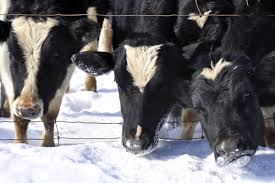As temperatures continue to drop, dairy and beef cattle and their offspring are at increased risk for cold stress said SDSU Extension Dairy Specialist Alvaro Garcia.  “With daytime temperatures in the double digits below zero for next week, Dairy producers should be prepared for cold weather conditions that can affect young stock and lactating cows,” Garcia said.
“With daytime temperatures in the double digits below zero for next week, Dairy producers should be prepared for cold weather conditions that can affect young stock and lactating cows,” Garcia said.
Lactating cows that are adequately fed should withstand cold conditions provided they are kept dry and not exposed directly to winds. Keep the housing area dry and free of manure and provide ample supply of dry clean bedding daily. Garcia noted that teat skin chapping (frostbite) can become a problem in lactating cows during cold, windy weather. Chapping makes the teat more susceptible to bacterial infections, particularly Staphylococcus. “Mastitis is a possible outcome, and the cows affected will have to be monitored closely,” Garcia said. “If injury has already occurred, skin chapping and loss of at least the teat end is likely. When the teat end is damaged, the sphincter that closes the teat canal is also non-functional, predisposing the quarter to bacterial invasion.”
Recent research indicates teat dipping should be continued during cold windy days. Pre- and post-milking teat dips should include skin conditioners like glycerin and lanolin. Producers should dry teats and udders effectively. Cows should not be turned outside on cold and windy days until the teat dip has dried for 1 minute. Garcia also pointed out the cold weather guidelines from the National Mastitis Council. They include: In very cold weather it may be advisable to dip just the teat end. When teats are dipped, dip only the end and blot off any excess with a single-use paper towel. Teats should be dry before turning cows out of the barn. Warming the teat dip reduces drying time. Windbreaks in outside holding areas provide some protection. Fresh cows with swollen udders are more susceptible to chapping. “Always remember that prevention is the key,” Garcia said. Calves & Cold Stress
When it comes to caring for calves, Tracey Erickson, SDSU Extension Dairy Field Specialist reminds producers that cold stress starts in calves who are less than 21 days of age if the temperature drops below 60 degrees; and that cold stress begins in calves greater than 42 days of age at or below 42 degrees. “Obviously, we are experiencing some serious cold stress right now,” she said.
Some tips to care for calves as well as mature cattle that she shares with beef and dairy cattle producers are as follows: Get them off to a good start in the first 48 hours of life – following proper protocols for newborn calves, especially getting into them warm, high quality colostrum.
Get calves dry & keep them dry. Deep & Dry bedding – Provide a proper nest; when they are laying down one should not be able to see the feet & legs of the calf. Calf blankets – even though they add extra expense, they are reusable and provide an extra layer of protection for calves Proper ventilation is important but you must also prevent direct drafts from hitting young calves
Additional feedings per day – 3 times a day feedings which will provide 1.5 pounds to 2.25 pounds of milk replacer powder per day with 20% fat are necessary to provide adequate energy intake daily. Be consistent in feeding times. Make sure milk is warm but yet does not scald the calves’ mouth. Other options of increasing caloric intake; When it is extremely cold feed 0.25 pounds per day of additional 60% fat supplement milk during the first 14 days of life . Many commercial products are available. Taper off feeding the supplement slowly as they start to consume starter. Provide warm water above 102 degrees F about 30 minutes after feeding. Be careful not to get it too hot though and scald the calves’ mouth. Provide a high quality, fresh starter daily (free of mold and fines), to encourage daily intake.
Lastly, producers/employees should take care of themselves so they can be vigilant and observant as they care for the animals.




